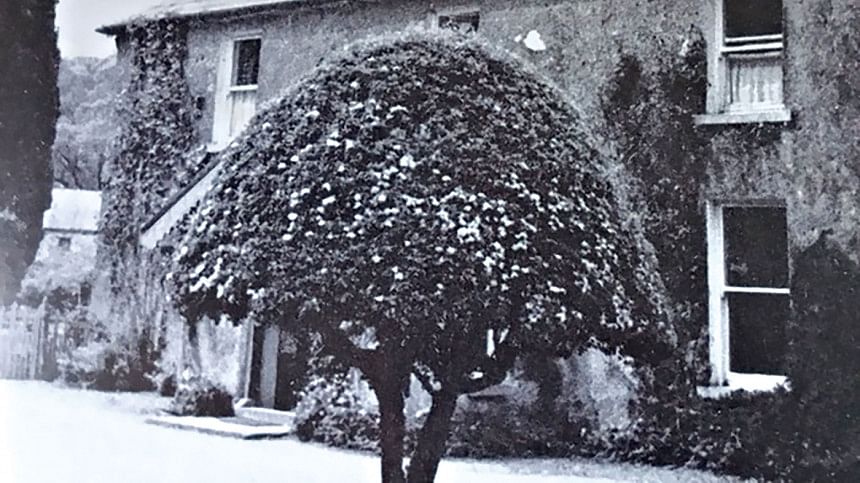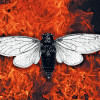In Ireland once: A story of ghosts

Killeaden
Are ghosts real? This was the question Mollie, a little 8-year-old girl who lives at the end of our street asked me in a–real–letter she wrote me recently. I had apparently included a book of ghost stories in a bag of books I had given her.
Mollie's question caused me to remember a holiday I had had on an estate in the west of Ireland some 65 years ago. Killeaden was not so much a Big House as a farmhouse of grey stone, approached by a long tree-lined drive. The grounds included a famous fairy fort, Lis Ard, beeches on its hill-top and ringed by a ditch as well as a bog providing the peat for its smouldering turf fires.
If the name of the estate is to be believed it was once the site of St Aidan's monkish cell. What it certainly was was the spiritual home of the last of the wandering minstrels, the blind poet Raftery, even after the then landlord, Frank Taaffe, banished him after the death of a horse in the bog on an outing to procure drink.
Exactly a hundred years ago, Bengali eyes were focussed on Ireland as it fought out a civil war over whether or not to accept the Partition that followed the winning of the War of Independence from Britain. India had charted out a similar path towards Home Rule, the Lucknow Pact of 1916 had brought both wings of Congress and the Muslim League together in common
The MacManus family, following the Taaffes, had owned Killeaden for more than a century but, though they loved it and returned to it–and shared the Catholic faith of the local people–they had been frightened by the Land Agitation of the 1880s and had gone to make their living in London.
Dr Desmond, the owner, was a physician to the King with a key to the back-gate of Buckingham Palace at the time of our visit, though his sister Emily, having been the Matron at Guy's Hospital, had returned to live on nearby Lough Conn, dispensing primary health care from what seemed to us to be the only car in County Mayo.
Two members of the family had become ardent Irish nationalists. The Doctor's brother Diarmuid, who had served the King-Emperor in India, threw in his lot with the IRA in the War of Independence and then with the Irish Free State during the bitter Civil War that followed. His aunt Lottie had foresworn England's Sussex to return to Killeaden and write patriotic stories of Irish heroes. Diarmuid wrote books about the invisible presences that haunted Killeaden, the goblin pooka dogs and the tetchy enchanted thorn trees.
In the house when I holidayed there with some friends were Miss Solon, the Housekeeper, an upright lady severely dressed in black, Miss Corless, the Assistant Housekeeper, and, up in the game-keeper's cottage, Patsy Cunningham and his wife. These were the permanent settlement.

First Story
These three were the source of our ghost stories. The first we heard, to our surprise from the austere Miss Solon, sitting before the earthy turf fire in the gunroom following a day in the fields saving the sweet-smelling hay. Miss Solon prefaced her story by telling us that the people in the local village were convinced the house was haunted by a ghost, a belief that had been confirmed by an experience during the Time of the Troubles.
A hundred years ago, one would not have needed to remind Bengalis that the Troubles in Ireland referred to the disturbed years of the War of Independence and Civil War, spanning 1919-1923. They were years when virtually the same pattern of events might well have taken place in India.
One moonlit night, the tree-lined drive of Killeaden was filled with a body of men with sticks, torches and lanterns, approaching the house intending mischief. Though the local people had respect for the MacManus family, who, if absent much of the year, were decent enough landlords and Catholics to boot, they were perhaps instigated by some IRA irregulars to do their patriotic bit.
had not Gandhi called off the Non-Cooperation Movement in 1922, events in India might have had much in common with those in Ireland. The following article, intended as a pleasant reminiscence about story-telling in Ireland, found itself confronted with some violent moments in its modern history. Perhaps aspects of this story will ring bells in Bangladeshi minds?
As the men came out into the forecourt of the house, a hazy figure in white appeared in the shadow of the porch and, standing motionless, stared them down. They turned tail with a yell and fled and nothing on earth, let alone the IRA, could have induced them to return.
Miss Solon, a ghost of a smile on her lips, explained that, as a young woman, she had only just joined the staff of the house at that time and left in charge with no expectation that the house would be threatened, was alarmed in bed one night to hear shouting in the drive. In panic, she had rushed down to the front door, opened it and then, not knowing what to do, stood transfixed.
It seemed an age but it was only moments before Miss Solon realised she was in her long white nightgown without even a shawl about her and she would have died of shame had the men not all turned tail and fled…
Second Story
On another evening, perhaps the day we had climbed one of the holy mountains, Croagh Patrick or Nephin, Miss Corless, a cheery sort, began by pointing out that, although there was an explanation for the ghost in Miss Solon's story, there were fairy stories about the estate that could not be explained so easily. She could cite an example that Miss Solon would also remember.
At one time there was a servant girl on the estate who made a habit of walking up to the fairy fort as of an evening. One evening the maid did not return in time for her kitchen duties and, since this was not unknown, it was not until nightfall an attempt was made to look for her. There was no sign of her up at the fort and no news of her either in the village when she was asked for there.
Next morning, the girl turned up, looking dazed. She had gone up to the fort as usual but when she tried to come down, an invisible barrier in the ditch had prevented her from leaving. She had tried to break out in various places, had even torn her clothes and, look you, had bruised her skin but the fairies had prevented her. She had left service soon after that, afraid of the fairies, she said.
It was in front of the turf fire in Patsy Cunningham's cottage, its earthy scent as beguiling as any myrrh or frankincense from Arabia, that we heard the explanation for Miss Corless's fairy story. It was not the fairies that had detained the servant girl up at the fairy fort, Patsy told us, but one of the local lads. She used to go up daily to meet him there and one evening the inevitable had happened and she stayed…
Third Story
I cannot for the life of me remember who told me the third story. I remember the story well enough but cannot recall the voice that told it. I am sure only it was someone who was sceptical of the existence of the spirit world of ghosts and fairies. Maybe it was Doctor MacManus himself back in mundane London.
The Doctor, on one of his annual holidays at Killeaden, found the people there speaking of little other than the sounds of footsteps being heard on the stairs at night. These did not pass out through the solid oak of the front door but stopped dead at the foot of the stairs.
The Doctor, determined to lay this particular ghost story to rest, called a lad from the stable yard to bring a jemmy and prize up the floorboard under the mat at the foot of the stairs. The floorboard taken up, the skeletons of a woman and infant were discovered to be lying there. It was with some difficulty the Doctor managed to persuade the local priest to re-bury these remains within the churchyard walls.
My concern to recall exactly who had told me this story combined with my memory of an enchanting summer in rural Ireland prevented me for all too long from trying to account for the bones discovered at the foot of the stairs.
Miss Solon's ghost story was delightful but it could have had a tragic ending. So, too, could that of the servant girl. Ireland these days is full of horrific stories of unmarried mothers being separated from their children in the 20th century, the mothers being put to work in Magdalen laundries for a pittance and the children incarcerated in equally awful religious institutions, so ill-treated many died young of disease, if not starvation, and were cast into mass graves.
Suddenly the romantic Ireland of my dreams and memories, the fairy-tale world of story-telling, was turning ugly. Surely, no amusing explanation could be found for the sinister position of the skeletons at the foot of the stairs: how had they come there?
Another historical memory the Irish have in common with the Bengalis is of one particular Famine among the many being unrelieved by the British during whose rule it occurred. In Ireland this was during the 1840s and, of the many who never took ship from Mayo's seaports to be buried in quarantine stations on the other side of the Atlantic, one in two failed to survive, let alone thrive on a diet of nettles, dock-leaves and, if lucky, Indian meal.
Did the (as we may suppose) mother and child at the foot of the stairs date from the time of the Great Potato Famine? The house had been in the hands of the Taaffe family since 1780. Frank's father, Patrick, killed a man in a duel and, before he could be arrested and hanged for it, was killed in another quarrel. These were openly violent times and the Taaffes were an old Anglo-Norman family with a sense of their seigneurial rights.
Frank Taaffe never relented to allow the blind poet Raftery to return to his belovèd Killeaden. If Raftery, romanticised in the Cultural Renaissance signalled by WB Yeats, Lady Gregory and Douglas Hyde, was tragically blinded by smallpox, his eight siblings were killed by it. Romantic Ireland's dead and gone? Was it ever there?
It would seem unlikely the staircase skeletons could be laid at the door of the MacManuses who took over Killeaden from the Taaffes about the time of the Famine. The first MacManus actually made a solemn promise standing on the slopes of Lis Ard to be a good landlord. And yet his son James who returned from abroad to refurbish the rambling, tumbledown old farmhouse was coming from managing a sugar plantation in Demerara.
Whatever ghosts may have greeted James on his arrival in stricken Ireland, what others, abused women and children, indentured Indians from Kolkata among them, may have followed his ship across the Ocean from that other even more devastating outpost of imperial progress? The desh of the Banglas shares a colonial history with Ireland: does it have equally unquiet ghosts waiting for their stories to be heard?
John Drew is a peripatetic poet, tutor and contributor to Star Literature.

 For all latest news, follow The Daily Star's Google News channel.
For all latest news, follow The Daily Star's Google News channel. 











Comments